Mental Health - Bipolar Disorder
VerifiedAdded on 2022/12/15
|17
|4429
|63
AI Summary
This article provides an overview of bipolar disorder, including its definition, symptoms, types, diagnostic criteria, causes, prevalence, co-morbidity, prognosis, prevention, and treatment. It discusses the impact of bipolar disorder on daily life and emphasizes the importance of seeking professional help for proper management.
Contribute Materials
Your contribution can guide someone’s learning journey. Share your
documents today.
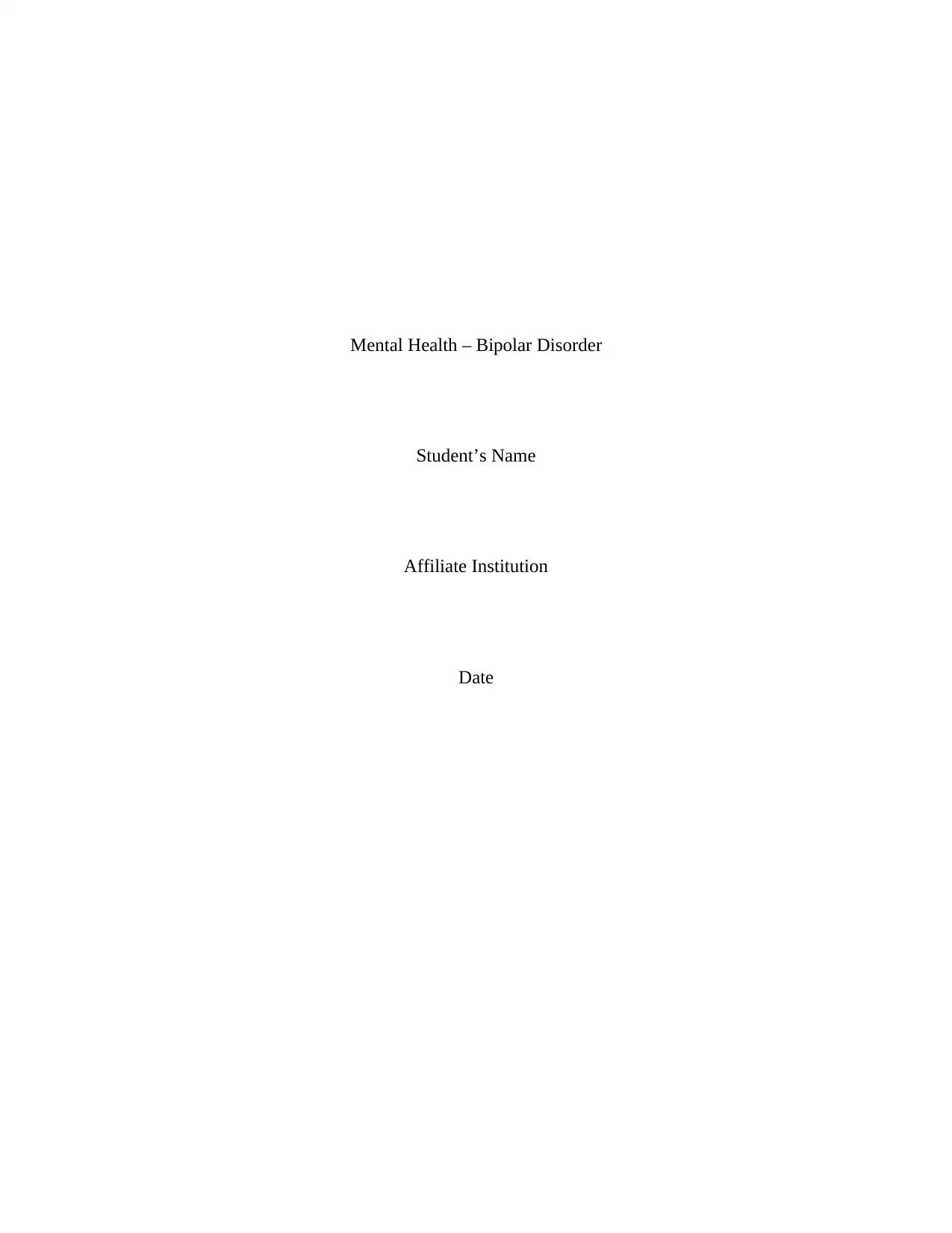
Mental Health – Bipolar Disorder
Student’s Name
Affiliate Institution
Date
Student’s Name
Affiliate Institution
Date
Secure Best Marks with AI Grader
Need help grading? Try our AI Grader for instant feedback on your assignments.
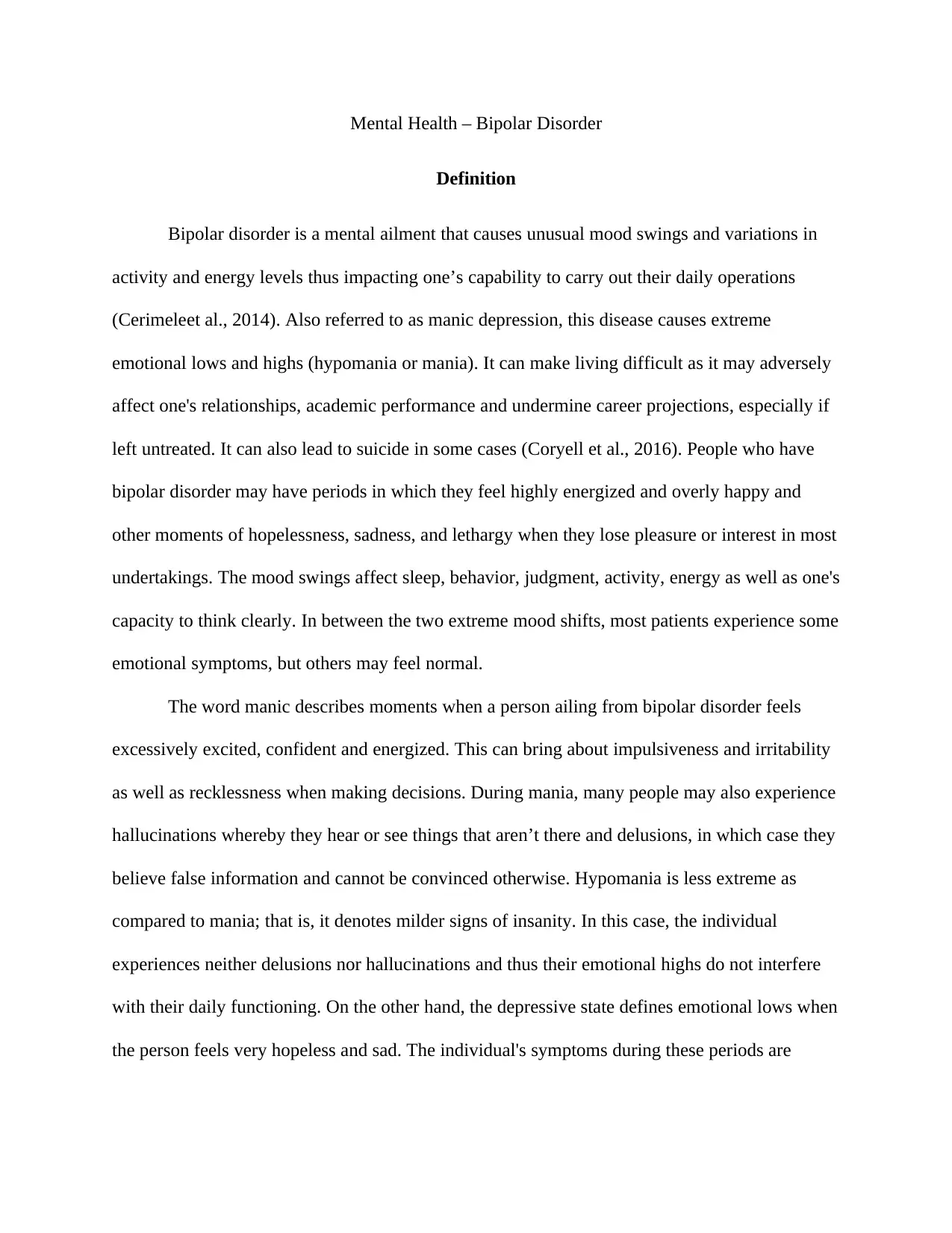
Mental Health – Bipolar Disorder
Definition
Bipolar disorder is a mental ailment that causes unusual mood swings and variations in
activity and energy levels thus impacting one’s capability to carry out their daily operations
(Cerimeleet al., 2014). Also referred to as manic depression, this disease causes extreme
emotional lows and highs (hypomania or mania). It can make living difficult as it may adversely
affect one's relationships, academic performance and undermine career projections, especially if
left untreated. It can also lead to suicide in some cases (Coryell et al., 2016). People who have
bipolar disorder may have periods in which they feel highly energized and overly happy and
other moments of hopelessness, sadness, and lethargy when they lose pleasure or interest in most
undertakings. The mood swings affect sleep, behavior, judgment, activity, energy as well as one's
capacity to think clearly. In between the two extreme mood shifts, most patients experience some
emotional symptoms, but others may feel normal.
The word manic describes moments when a person ailing from bipolar disorder feels
excessively excited, confident and energized. This can bring about impulsiveness and irritability
as well as recklessness when making decisions. During mania, many people may also experience
hallucinations whereby they hear or see things that aren’t there and delusions, in which case they
believe false information and cannot be convinced otherwise. Hypomania is less extreme as
compared to mania; that is, it denotes milder signs of insanity. In this case, the individual
experiences neither delusions nor hallucinations and thus their emotional highs do not interfere
with their daily functioning. On the other hand, the depressive state defines emotional lows when
the person feels very hopeless and sad. The individual's symptoms during these periods are
Definition
Bipolar disorder is a mental ailment that causes unusual mood swings and variations in
activity and energy levels thus impacting one’s capability to carry out their daily operations
(Cerimeleet al., 2014). Also referred to as manic depression, this disease causes extreme
emotional lows and highs (hypomania or mania). It can make living difficult as it may adversely
affect one's relationships, academic performance and undermine career projections, especially if
left untreated. It can also lead to suicide in some cases (Coryell et al., 2016). People who have
bipolar disorder may have periods in which they feel highly energized and overly happy and
other moments of hopelessness, sadness, and lethargy when they lose pleasure or interest in most
undertakings. The mood swings affect sleep, behavior, judgment, activity, energy as well as one's
capacity to think clearly. In between the two extreme mood shifts, most patients experience some
emotional symptoms, but others may feel normal.
The word manic describes moments when a person ailing from bipolar disorder feels
excessively excited, confident and energized. This can bring about impulsiveness and irritability
as well as recklessness when making decisions. During mania, many people may also experience
hallucinations whereby they hear or see things that aren’t there and delusions, in which case they
believe false information and cannot be convinced otherwise. Hypomania is less extreme as
compared to mania; that is, it denotes milder signs of insanity. In this case, the individual
experiences neither delusions nor hallucinations and thus their emotional highs do not interfere
with their daily functioning. On the other hand, the depressive state defines emotional lows when
the person feels very hopeless and sad. The individual's symptoms during these periods are
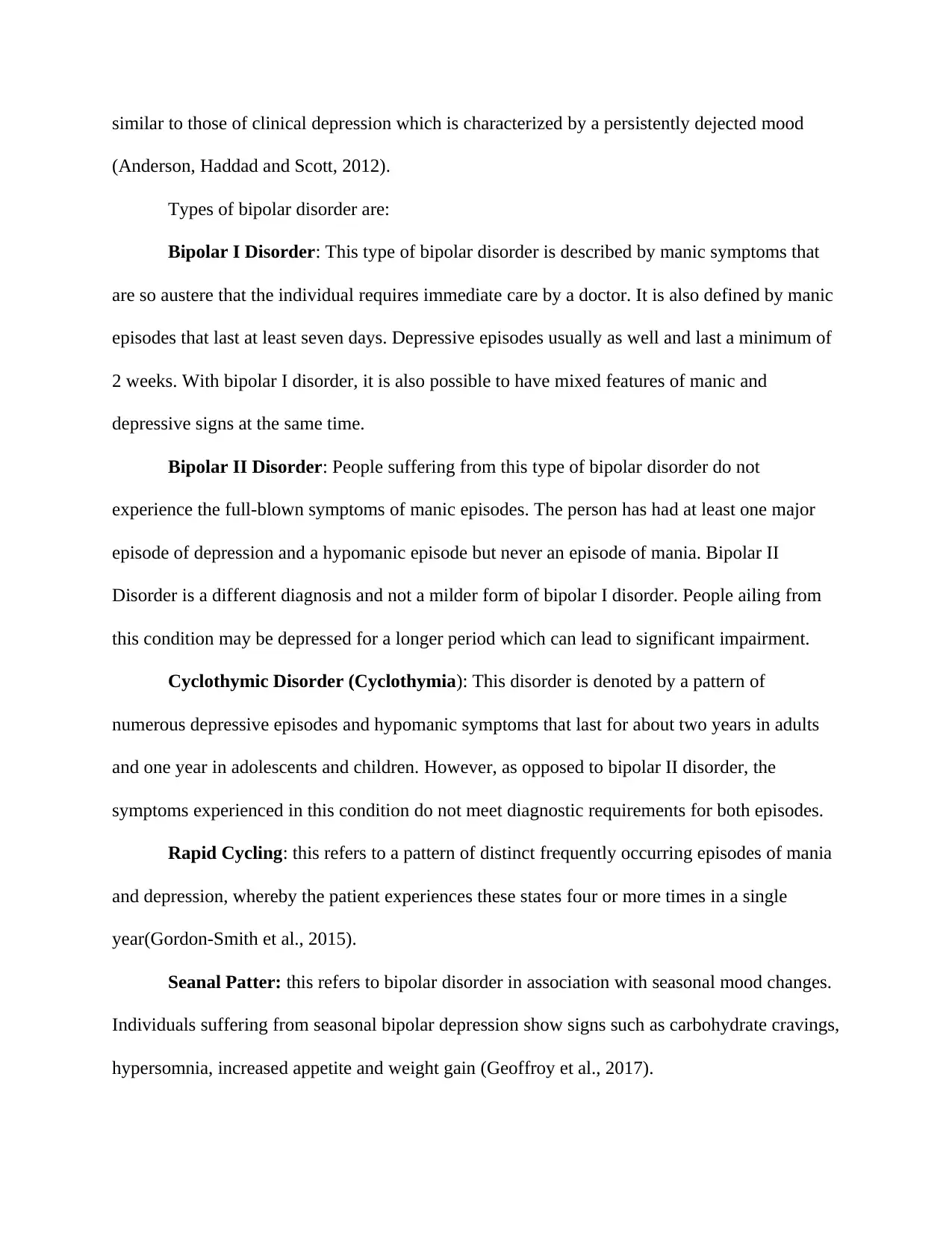
similar to those of clinical depression which is characterized by a persistently dejected mood
(Anderson, Haddad and Scott, 2012).
Types of bipolar disorder are:
Bipolar I Disorder: This type of bipolar disorder is described by manic symptoms that
are so austere that the individual requires immediate care by a doctor. It is also defined by manic
episodes that last at least seven days. Depressive episodes usually as well and last a minimum of
2 weeks. With bipolar I disorder, it is also possible to have mixed features of manic and
depressive signs at the same time.
Bipolar II Disorder: People suffering from this type of bipolar disorder do not
experience the full-blown symptoms of manic episodes. The person has had at least one major
episode of depression and a hypomanic episode but never an episode of mania. Bipolar II
Disorder is a different diagnosis and not a milder form of bipolar I disorder. People ailing from
this condition may be depressed for a longer period which can lead to significant impairment.
Cyclothymic Disorder (Cyclothymia): This disorder is denoted by a pattern of
numerous depressive episodes and hypomanic symptoms that last for about two years in adults
and one year in adolescents and children. However, as opposed to bipolar II disorder, the
symptoms experienced in this condition do not meet diagnostic requirements for both episodes.
Rapid Cycling: this refers to a pattern of distinct frequently occurring episodes of mania
and depression, whereby the patient experiences these states four or more times in a single
year(Gordon-Smith et al., 2015).
Seanal Patter: this refers to bipolar disorder in association with seasonal mood changes.
Individuals suffering from seasonal bipolar depression show signs such as carbohydrate cravings,
hypersomnia, increased appetite and weight gain (Geoffroy et al., 2017).
(Anderson, Haddad and Scott, 2012).
Types of bipolar disorder are:
Bipolar I Disorder: This type of bipolar disorder is described by manic symptoms that
are so austere that the individual requires immediate care by a doctor. It is also defined by manic
episodes that last at least seven days. Depressive episodes usually as well and last a minimum of
2 weeks. With bipolar I disorder, it is also possible to have mixed features of manic and
depressive signs at the same time.
Bipolar II Disorder: People suffering from this type of bipolar disorder do not
experience the full-blown symptoms of manic episodes. The person has had at least one major
episode of depression and a hypomanic episode but never an episode of mania. Bipolar II
Disorder is a different diagnosis and not a milder form of bipolar I disorder. People ailing from
this condition may be depressed for a longer period which can lead to significant impairment.
Cyclothymic Disorder (Cyclothymia): This disorder is denoted by a pattern of
numerous depressive episodes and hypomanic symptoms that last for about two years in adults
and one year in adolescents and children. However, as opposed to bipolar II disorder, the
symptoms experienced in this condition do not meet diagnostic requirements for both episodes.
Rapid Cycling: this refers to a pattern of distinct frequently occurring episodes of mania
and depression, whereby the patient experiences these states four or more times in a single
year(Gordon-Smith et al., 2015).
Seanal Patter: this refers to bipolar disorder in association with seasonal mood changes.
Individuals suffering from seasonal bipolar depression show signs such as carbohydrate cravings,
hypersomnia, increased appetite and weight gain (Geoffroy et al., 2017).
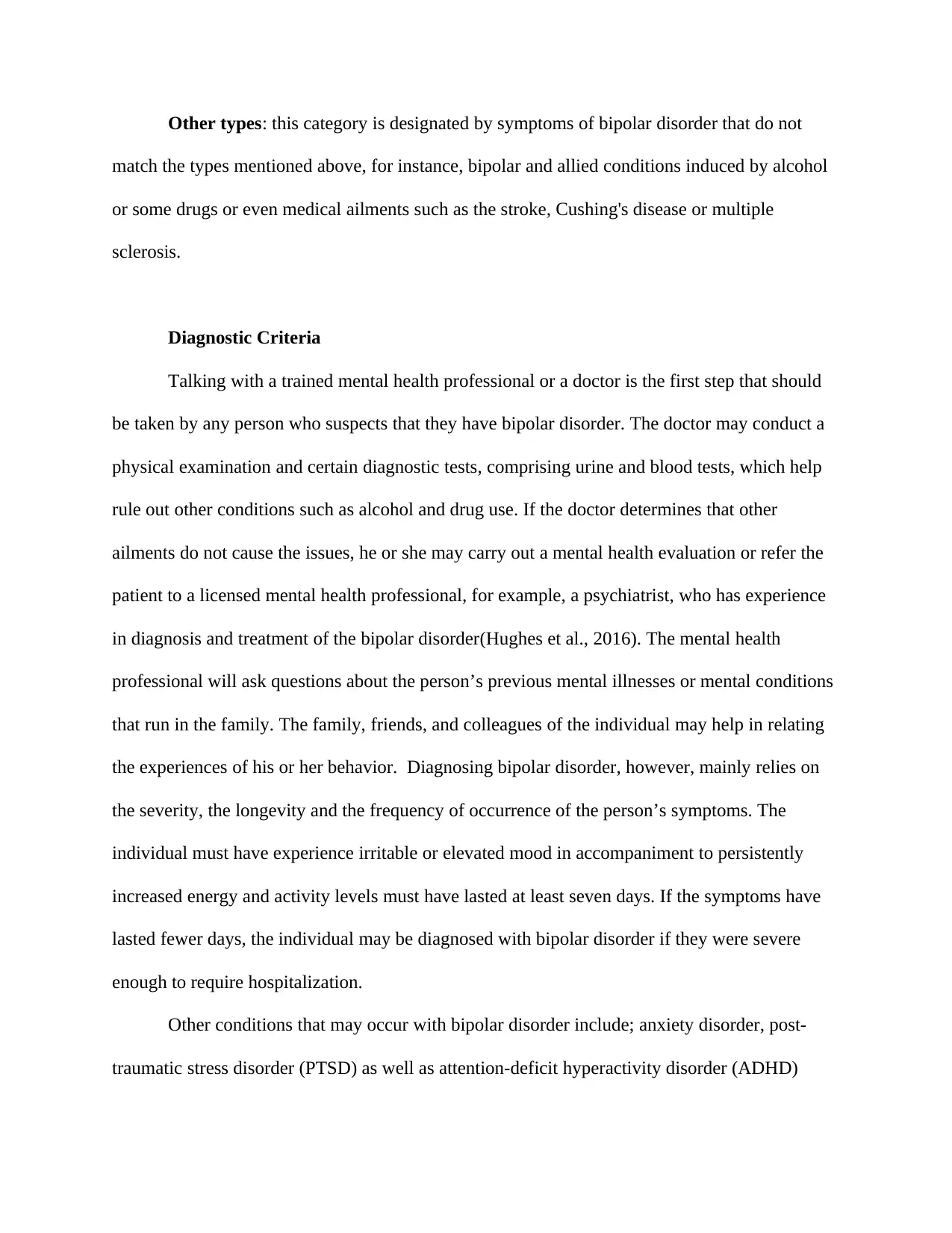
Other types: this category is designated by symptoms of bipolar disorder that do not
match the types mentioned above, for instance, bipolar and allied conditions induced by alcohol
or some drugs or even medical ailments such as the stroke, Cushing's disease or multiple
sclerosis.
Diagnostic Criteria
Talking with a trained mental health professional or a doctor is the first step that should
be taken by any person who suspects that they have bipolar disorder. The doctor may conduct a
physical examination and certain diagnostic tests, comprising urine and blood tests, which help
rule out other conditions such as alcohol and drug use. If the doctor determines that other
ailments do not cause the issues, he or she may carry out a mental health evaluation or refer the
patient to a licensed mental health professional, for example, a psychiatrist, who has experience
in diagnosis and treatment of the bipolar disorder(Hughes et al., 2016). The mental health
professional will ask questions about the person’s previous mental illnesses or mental conditions
that run in the family. The family, friends, and colleagues of the individual may help in relating
the experiences of his or her behavior. Diagnosing bipolar disorder, however, mainly relies on
the severity, the longevity and the frequency of occurrence of the person’s symptoms. The
individual must have experience irritable or elevated mood in accompaniment to persistently
increased energy and activity levels must have lasted at least seven days. If the symptoms have
lasted fewer days, the individual may be diagnosed with bipolar disorder if they were severe
enough to require hospitalization.
Other conditions that may occur with bipolar disorder include; anxiety disorder, post-
traumatic stress disorder (PTSD) as well as attention-deficit hyperactivity disorder (ADHD)
match the types mentioned above, for instance, bipolar and allied conditions induced by alcohol
or some drugs or even medical ailments such as the stroke, Cushing's disease or multiple
sclerosis.
Diagnostic Criteria
Talking with a trained mental health professional or a doctor is the first step that should
be taken by any person who suspects that they have bipolar disorder. The doctor may conduct a
physical examination and certain diagnostic tests, comprising urine and blood tests, which help
rule out other conditions such as alcohol and drug use. If the doctor determines that other
ailments do not cause the issues, he or she may carry out a mental health evaluation or refer the
patient to a licensed mental health professional, for example, a psychiatrist, who has experience
in diagnosis and treatment of the bipolar disorder(Hughes et al., 2016). The mental health
professional will ask questions about the person’s previous mental illnesses or mental conditions
that run in the family. The family, friends, and colleagues of the individual may help in relating
the experiences of his or her behavior. Diagnosing bipolar disorder, however, mainly relies on
the severity, the longevity and the frequency of occurrence of the person’s symptoms. The
individual must have experience irritable or elevated mood in accompaniment to persistently
increased energy and activity levels must have lasted at least seven days. If the symptoms have
lasted fewer days, the individual may be diagnosed with bipolar disorder if they were severe
enough to require hospitalization.
Other conditions that may occur with bipolar disorder include; anxiety disorder, post-
traumatic stress disorder (PTSD) as well as attention-deficit hyperactivity disorder (ADHD)
Secure Best Marks with AI Grader
Need help grading? Try our AI Grader for instant feedback on your assignments.
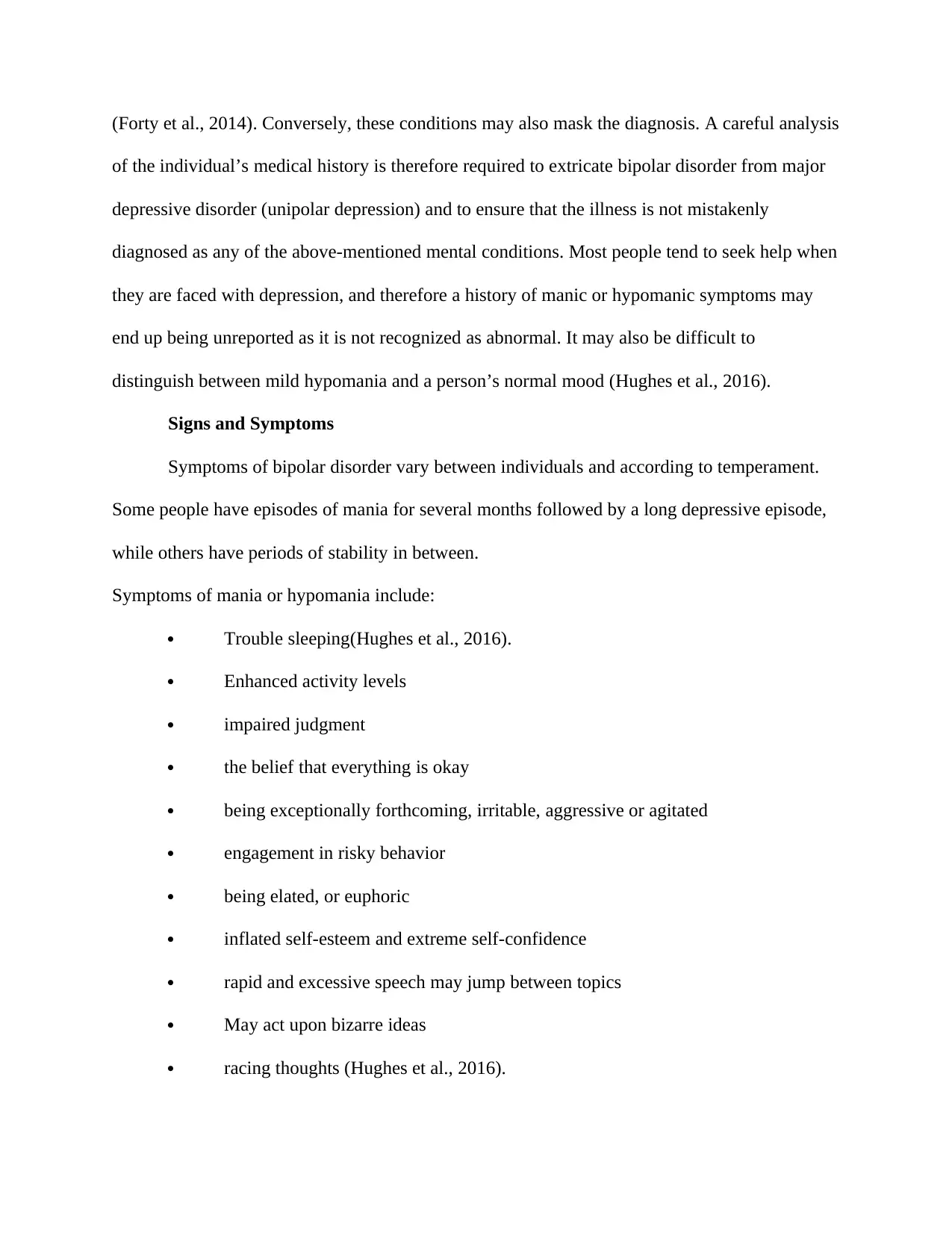
(Forty et al., 2014). Conversely, these conditions may also mask the diagnosis. A careful analysis
of the individual’s medical history is therefore required to extricate bipolar disorder from major
depressive disorder (unipolar depression) and to ensure that the illness is not mistakenly
diagnosed as any of the above-mentioned mental conditions. Most people tend to seek help when
they are faced with depression, and therefore a history of manic or hypomanic symptoms may
end up being unreported as it is not recognized as abnormal. It may also be difficult to
distinguish between mild hypomania and a person’s normal mood (Hughes et al., 2016).
Signs and Symptoms
Symptoms of bipolar disorder vary between individuals and according to temperament.
Some people have episodes of mania for several months followed by a long depressive episode,
while others have periods of stability in between.
Symptoms of mania or hypomania include:
Trouble sleeping(Hughes et al., 2016).
Enhanced activity levels
impaired judgment
the belief that everything is okay
being exceptionally forthcoming, irritable, aggressive or agitated
engagement in risky behavior
being elated, or euphoric
inflated self-esteem and extreme self-confidence
rapid and excessive speech may jump between topics
May act upon bizarre ideas
racing thoughts (Hughes et al., 2016).
of the individual’s medical history is therefore required to extricate bipolar disorder from major
depressive disorder (unipolar depression) and to ensure that the illness is not mistakenly
diagnosed as any of the above-mentioned mental conditions. Most people tend to seek help when
they are faced with depression, and therefore a history of manic or hypomanic symptoms may
end up being unreported as it is not recognized as abnormal. It may also be difficult to
distinguish between mild hypomania and a person’s normal mood (Hughes et al., 2016).
Signs and Symptoms
Symptoms of bipolar disorder vary between individuals and according to temperament.
Some people have episodes of mania for several months followed by a long depressive episode,
while others have periods of stability in between.
Symptoms of mania or hypomania include:
Trouble sleeping(Hughes et al., 2016).
Enhanced activity levels
impaired judgment
the belief that everything is okay
being exceptionally forthcoming, irritable, aggressive or agitated
engagement in risky behavior
being elated, or euphoric
inflated self-esteem and extreme self-confidence
rapid and excessive speech may jump between topics
May act upon bizarre ideas
racing thoughts (Hughes et al., 2016).
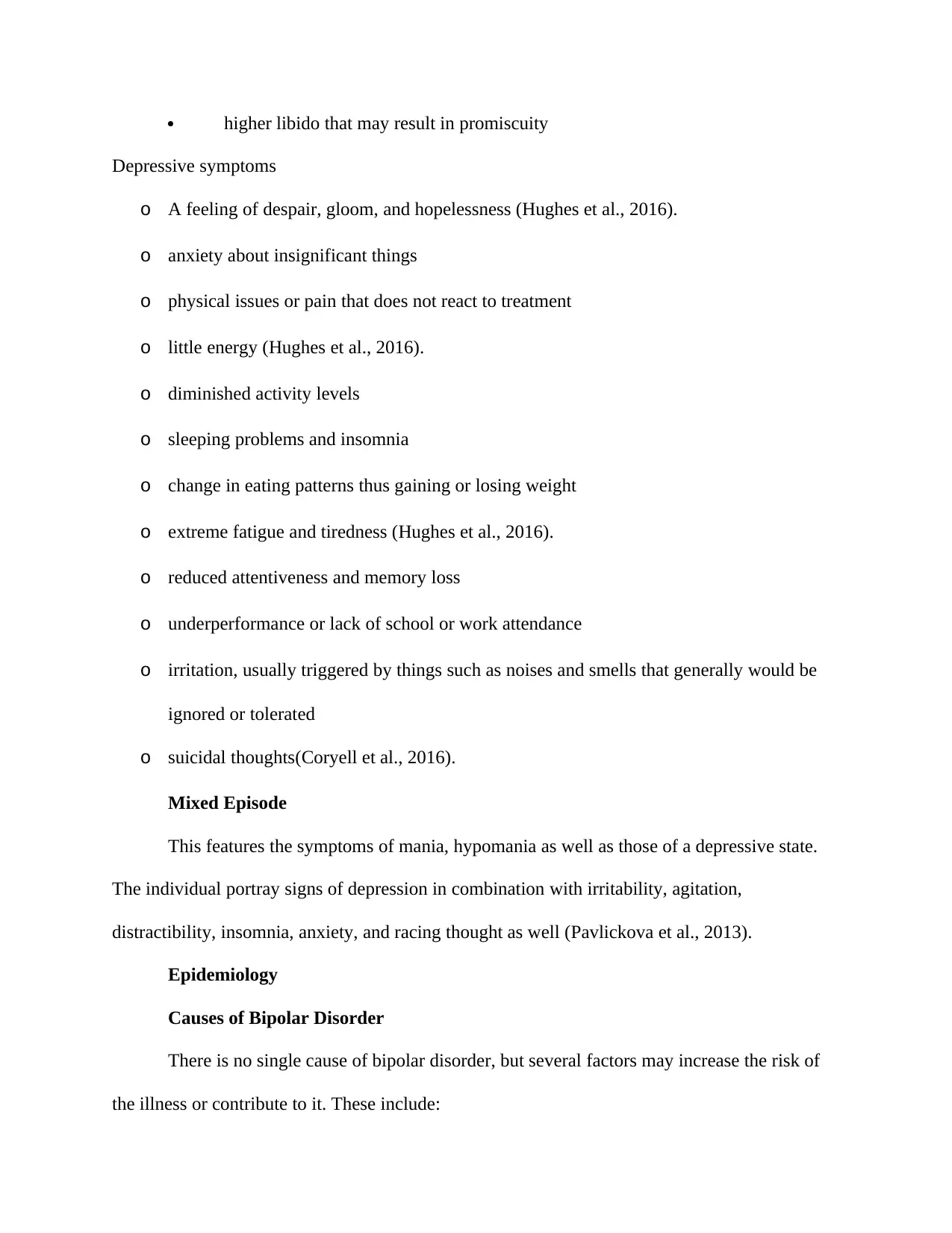
higher libido that may result in promiscuity
Depressive symptoms
o A feeling of despair, gloom, and hopelessness (Hughes et al., 2016).
o anxiety about insignificant things
o physical issues or pain that does not react to treatment
o little energy (Hughes et al., 2016).
o diminished activity levels
o sleeping problems and insomnia
o change in eating patterns thus gaining or losing weight
o extreme fatigue and tiredness (Hughes et al., 2016).
o reduced attentiveness and memory loss
o underperformance or lack of school or work attendance
o irritation, usually triggered by things such as noises and smells that generally would be
ignored or tolerated
o suicidal thoughts(Coryell et al., 2016).
Mixed Episode
This features the symptoms of mania, hypomania as well as those of a depressive state.
The individual portray signs of depression in combination with irritability, agitation,
distractibility, insomnia, anxiety, and racing thought as well (Pavlickova et al., 2013).
Epidemiology
Causes of Bipolar Disorder
There is no single cause of bipolar disorder, but several factors may increase the risk of
the illness or contribute to it. These include:
Depressive symptoms
o A feeling of despair, gloom, and hopelessness (Hughes et al., 2016).
o anxiety about insignificant things
o physical issues or pain that does not react to treatment
o little energy (Hughes et al., 2016).
o diminished activity levels
o sleeping problems and insomnia
o change in eating patterns thus gaining or losing weight
o extreme fatigue and tiredness (Hughes et al., 2016).
o reduced attentiveness and memory loss
o underperformance or lack of school or work attendance
o irritation, usually triggered by things such as noises and smells that generally would be
ignored or tolerated
o suicidal thoughts(Coryell et al., 2016).
Mixed Episode
This features the symptoms of mania, hypomania as well as those of a depressive state.
The individual portray signs of depression in combination with irritability, agitation,
distractibility, insomnia, anxiety, and racing thought as well (Pavlickova et al., 2013).
Epidemiology
Causes of Bipolar Disorder
There is no single cause of bipolar disorder, but several factors may increase the risk of
the illness or contribute to it. These include:
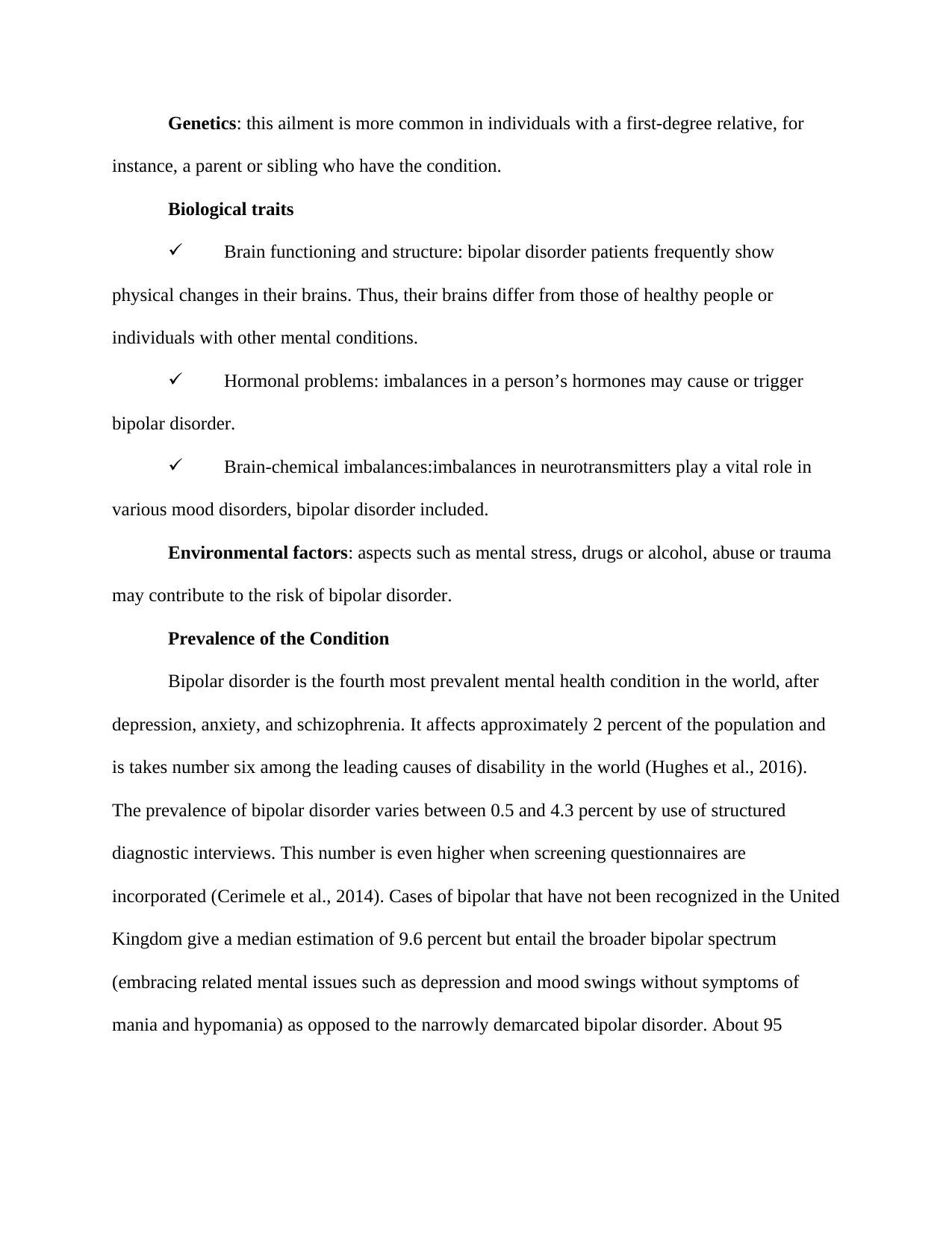
Genetics: this ailment is more common in individuals with a first-degree relative, for
instance, a parent or sibling who have the condition.
Biological traits
Brain functioning and structure: bipolar disorder patients frequently show
physical changes in their brains. Thus, their brains differ from those of healthy people or
individuals with other mental conditions.
Hormonal problems: imbalances in a person’s hormones may cause or trigger
bipolar disorder.
Brain-chemical imbalances:imbalances in neurotransmitters play a vital role in
various mood disorders, bipolar disorder included.
Environmental factors: aspects such as mental stress, drugs or alcohol, abuse or trauma
may contribute to the risk of bipolar disorder.
Prevalence of the Condition
Bipolar disorder is the fourth most prevalent mental health condition in the world, after
depression, anxiety, and schizophrenia. It affects approximately 2 percent of the population and
is takes number six among the leading causes of disability in the world (Hughes et al., 2016).
The prevalence of bipolar disorder varies between 0.5 and 4.3 percent by use of structured
diagnostic interviews. This number is even higher when screening questionnaires are
incorporated (Cerimele et al., 2014). Cases of bipolar that have not been recognized in the United
Kingdom give a median estimation of 9.6 percent but entail the broader bipolar spectrum
(embracing related mental issues such as depression and mood swings without symptoms of
mania and hypomania) as opposed to the narrowly demarcated bipolar disorder. About 95
instance, a parent or sibling who have the condition.
Biological traits
Brain functioning and structure: bipolar disorder patients frequently show
physical changes in their brains. Thus, their brains differ from those of healthy people or
individuals with other mental conditions.
Hormonal problems: imbalances in a person’s hormones may cause or trigger
bipolar disorder.
Brain-chemical imbalances:imbalances in neurotransmitters play a vital role in
various mood disorders, bipolar disorder included.
Environmental factors: aspects such as mental stress, drugs or alcohol, abuse or trauma
may contribute to the risk of bipolar disorder.
Prevalence of the Condition
Bipolar disorder is the fourth most prevalent mental health condition in the world, after
depression, anxiety, and schizophrenia. It affects approximately 2 percent of the population and
is takes number six among the leading causes of disability in the world (Hughes et al., 2016).
The prevalence of bipolar disorder varies between 0.5 and 4.3 percent by use of structured
diagnostic interviews. This number is even higher when screening questionnaires are
incorporated (Cerimele et al., 2014). Cases of bipolar that have not been recognized in the United
Kingdom give a median estimation of 9.6 percent but entail the broader bipolar spectrum
(embracing related mental issues such as depression and mood swings without symptoms of
mania and hypomania) as opposed to the narrowly demarcated bipolar disorder. About 95
Paraphrase This Document
Need a fresh take? Get an instant paraphrase of this document with our AI Paraphraser
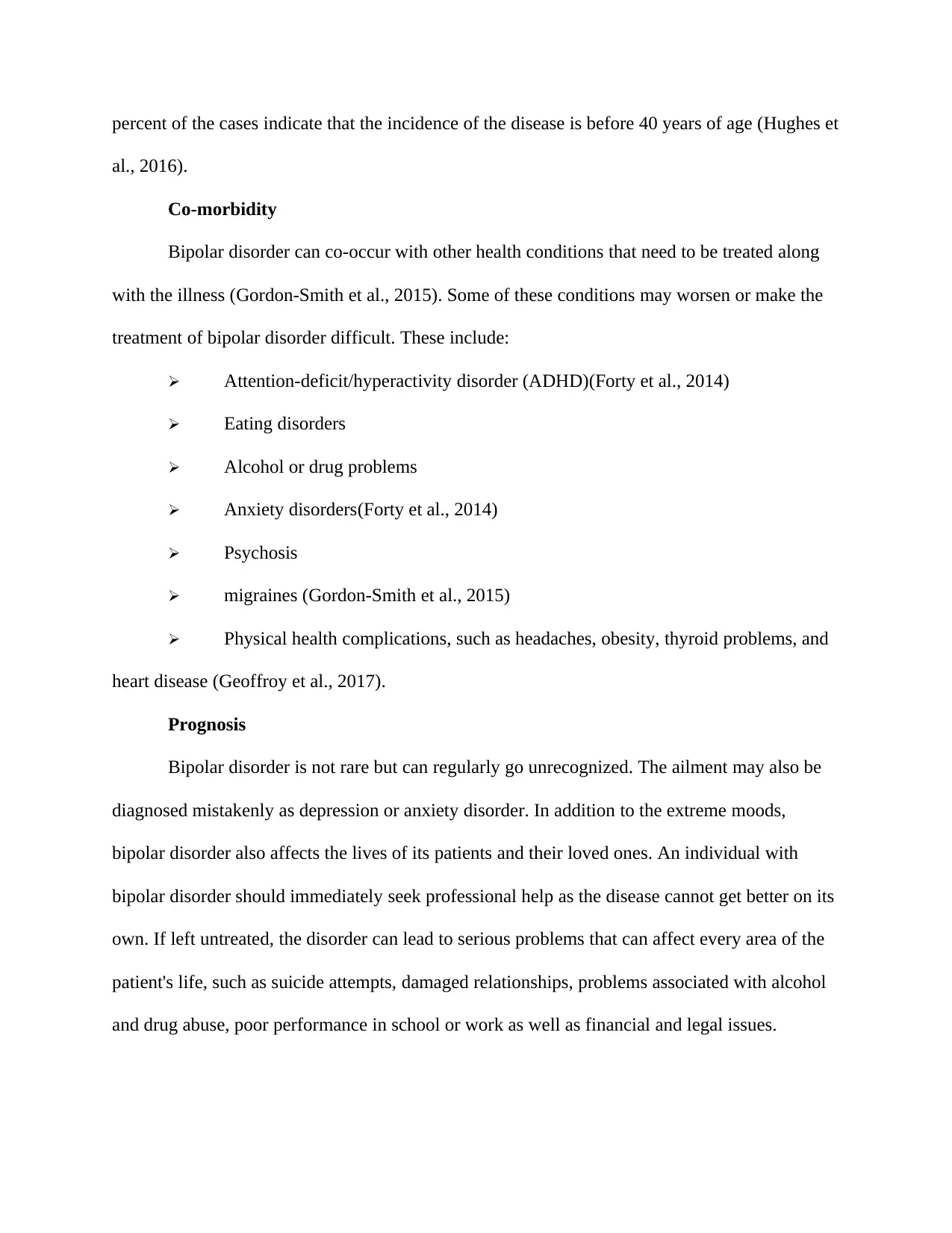
percent of the cases indicate that the incidence of the disease is before 40 years of age (Hughes et
al., 2016).
Co-morbidity
Bipolar disorder can co-occur with other health conditions that need to be treated along
with the illness (Gordon-Smith et al., 2015). Some of these conditions may worsen or make the
treatment of bipolar disorder difficult. These include:
Attention-deficit/hyperactivity disorder (ADHD)(Forty et al., 2014)
Eating disorders
Alcohol or drug problems
Anxiety disorders(Forty et al., 2014)
Psychosis
migraines (Gordon-Smith et al., 2015)
Physical health complications, such as headaches, obesity, thyroid problems, and
heart disease (Geoffroy et al., 2017).
Prognosis
Bipolar disorder is not rare but can regularly go unrecognized. The ailment may also be
diagnosed mistakenly as depression or anxiety disorder. In addition to the extreme moods,
bipolar disorder also affects the lives of its patients and their loved ones. An individual with
bipolar disorder should immediately seek professional help as the disease cannot get better on its
own. If left untreated, the disorder can lead to serious problems that can affect every area of the
patient's life, such as suicide attempts, damaged relationships, problems associated with alcohol
and drug abuse, poor performance in school or work as well as financial and legal issues.
al., 2016).
Co-morbidity
Bipolar disorder can co-occur with other health conditions that need to be treated along
with the illness (Gordon-Smith et al., 2015). Some of these conditions may worsen or make the
treatment of bipolar disorder difficult. These include:
Attention-deficit/hyperactivity disorder (ADHD)(Forty et al., 2014)
Eating disorders
Alcohol or drug problems
Anxiety disorders(Forty et al., 2014)
Psychosis
migraines (Gordon-Smith et al., 2015)
Physical health complications, such as headaches, obesity, thyroid problems, and
heart disease (Geoffroy et al., 2017).
Prognosis
Bipolar disorder is not rare but can regularly go unrecognized. The ailment may also be
diagnosed mistakenly as depression or anxiety disorder. In addition to the extreme moods,
bipolar disorder also affects the lives of its patients and their loved ones. An individual with
bipolar disorder should immediately seek professional help as the disease cannot get better on its
own. If left untreated, the disorder can lead to serious problems that can affect every area of the
patient's life, such as suicide attempts, damaged relationships, problems associated with alcohol
and drug abuse, poor performance in school or work as well as financial and legal issues.
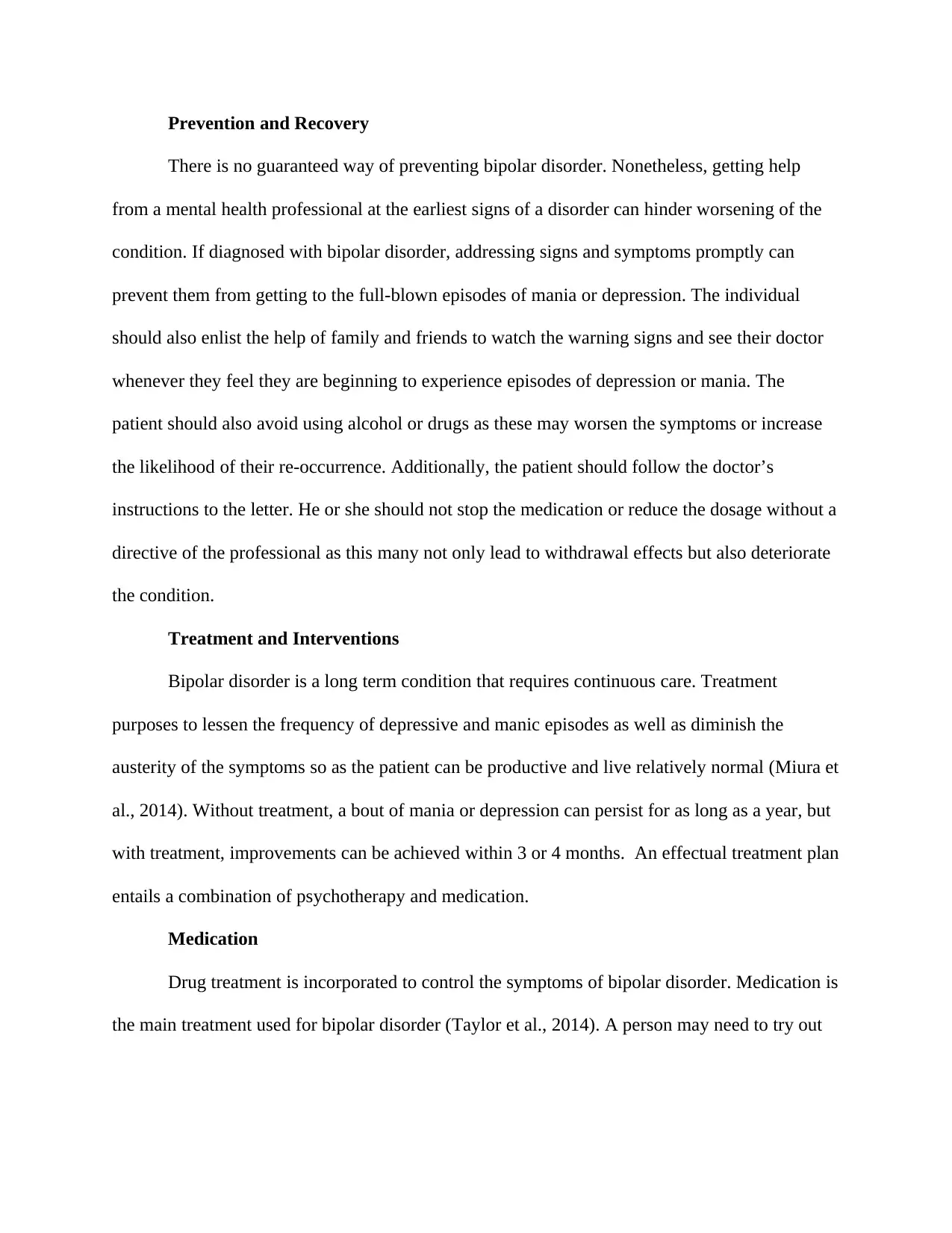
Prevention and Recovery
There is no guaranteed way of preventing bipolar disorder. Nonetheless, getting help
from a mental health professional at the earliest signs of a disorder can hinder worsening of the
condition. If diagnosed with bipolar disorder, addressing signs and symptoms promptly can
prevent them from getting to the full-blown episodes of mania or depression. The individual
should also enlist the help of family and friends to watch the warning signs and see their doctor
whenever they feel they are beginning to experience episodes of depression or mania. The
patient should also avoid using alcohol or drugs as these may worsen the symptoms or increase
the likelihood of their re-occurrence. Additionally, the patient should follow the doctor’s
instructions to the letter. He or she should not stop the medication or reduce the dosage without a
directive of the professional as this many not only lead to withdrawal effects but also deteriorate
the condition.
Treatment and Interventions
Bipolar disorder is a long term condition that requires continuous care. Treatment
purposes to lessen the frequency of depressive and manic episodes as well as diminish the
austerity of the symptoms so as the patient can be productive and live relatively normal (Miura et
al., 2014). Without treatment, a bout of mania or depression can persist for as long as a year, but
with treatment, improvements can be achieved within 3 or 4 months. An effectual treatment plan
entails a combination of psychotherapy and medication.
Medication
Drug treatment is incorporated to control the symptoms of bipolar disorder. Medication is
the main treatment used for bipolar disorder (Taylor et al., 2014). A person may need to try out
There is no guaranteed way of preventing bipolar disorder. Nonetheless, getting help
from a mental health professional at the earliest signs of a disorder can hinder worsening of the
condition. If diagnosed with bipolar disorder, addressing signs and symptoms promptly can
prevent them from getting to the full-blown episodes of mania or depression. The individual
should also enlist the help of family and friends to watch the warning signs and see their doctor
whenever they feel they are beginning to experience episodes of depression or mania. The
patient should also avoid using alcohol or drugs as these may worsen the symptoms or increase
the likelihood of their re-occurrence. Additionally, the patient should follow the doctor’s
instructions to the letter. He or she should not stop the medication or reduce the dosage without a
directive of the professional as this many not only lead to withdrawal effects but also deteriorate
the condition.
Treatment and Interventions
Bipolar disorder is a long term condition that requires continuous care. Treatment
purposes to lessen the frequency of depressive and manic episodes as well as diminish the
austerity of the symptoms so as the patient can be productive and live relatively normal (Miura et
al., 2014). Without treatment, a bout of mania or depression can persist for as long as a year, but
with treatment, improvements can be achieved within 3 or 4 months. An effectual treatment plan
entails a combination of psychotherapy and medication.
Medication
Drug treatment is incorporated to control the symptoms of bipolar disorder. Medication is
the main treatment used for bipolar disorder (Taylor et al., 2014). A person may need to try out
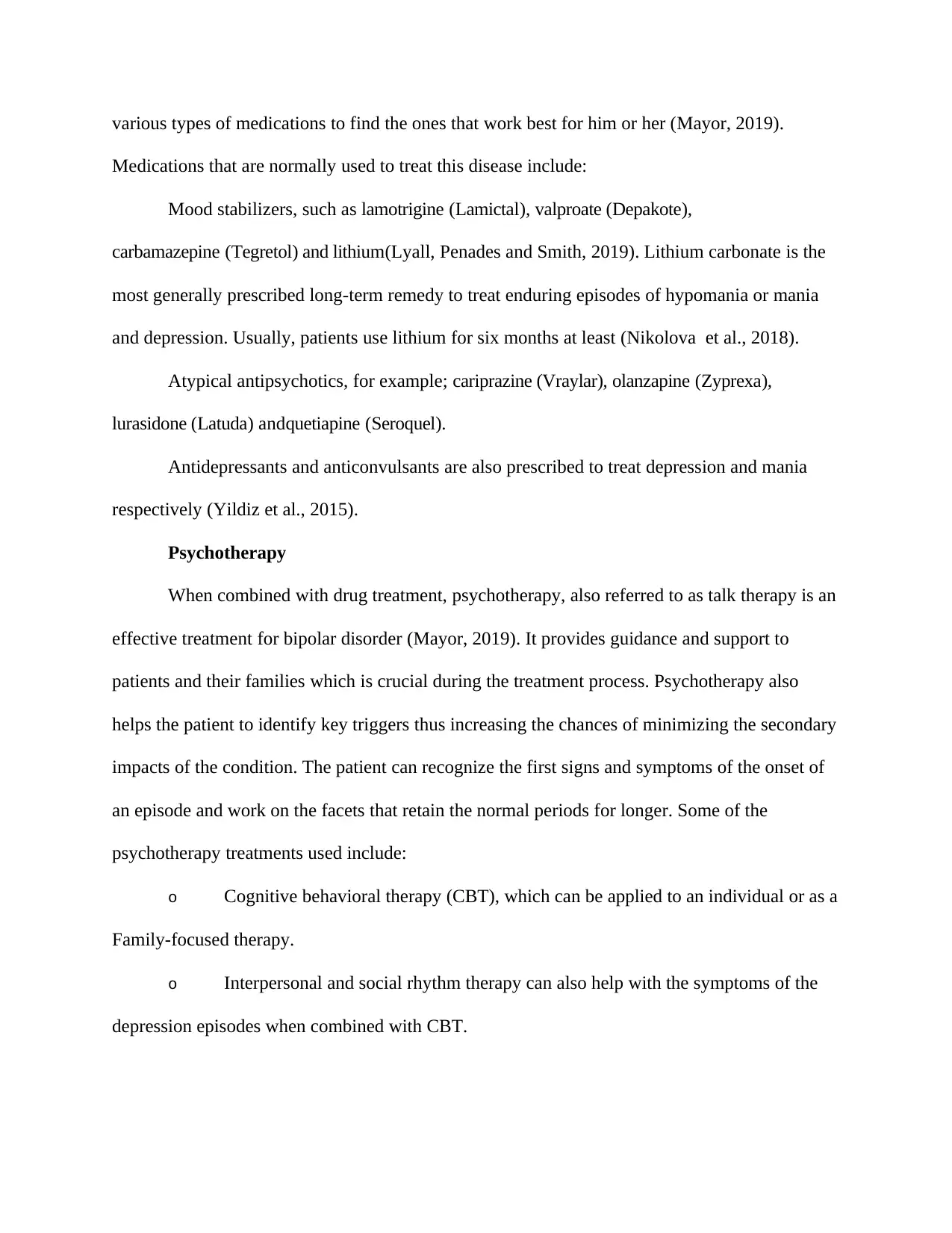
various types of medications to find the ones that work best for him or her (Mayor, 2019).
Medications that are normally used to treat this disease include:
Mood stabilizers, such as lamotrigine (Lamictal), valproate (Depakote),
carbamazepine (Tegretol) and lithium(Lyall, Penades and Smith, 2019). Lithium carbonate is the
most generally prescribed long-term remedy to treat enduring episodes of hypomania or mania
and depression. Usually, patients use lithium for six months at least (Nikolova et al., 2018).
Atypical antipsychotics, for example; cariprazine (Vraylar), olanzapine (Zyprexa),
lurasidone (Latuda) andquetiapine (Seroquel).
Antidepressants and anticonvulsants are also prescribed to treat depression and mania
respectively (Yildiz et al., 2015).
Psychotherapy
When combined with drug treatment, psychotherapy, also referred to as talk therapy is an
effective treatment for bipolar disorder (Mayor, 2019). It provides guidance and support to
patients and their families which is crucial during the treatment process. Psychotherapy also
helps the patient to identify key triggers thus increasing the chances of minimizing the secondary
impacts of the condition. The patient can recognize the first signs and symptoms of the onset of
an episode and work on the facets that retain the normal periods for longer. Some of the
psychotherapy treatments used include:
o Cognitive behavioral therapy (CBT), which can be applied to an individual or as a
Family-focused therapy.
o Interpersonal and social rhythm therapy can also help with the symptoms of the
depression episodes when combined with CBT.
Medications that are normally used to treat this disease include:
Mood stabilizers, such as lamotrigine (Lamictal), valproate (Depakote),
carbamazepine (Tegretol) and lithium(Lyall, Penades and Smith, 2019). Lithium carbonate is the
most generally prescribed long-term remedy to treat enduring episodes of hypomania or mania
and depression. Usually, patients use lithium for six months at least (Nikolova et al., 2018).
Atypical antipsychotics, for example; cariprazine (Vraylar), olanzapine (Zyprexa),
lurasidone (Latuda) andquetiapine (Seroquel).
Antidepressants and anticonvulsants are also prescribed to treat depression and mania
respectively (Yildiz et al., 2015).
Psychotherapy
When combined with drug treatment, psychotherapy, also referred to as talk therapy is an
effective treatment for bipolar disorder (Mayor, 2019). It provides guidance and support to
patients and their families which is crucial during the treatment process. Psychotherapy also
helps the patient to identify key triggers thus increasing the chances of minimizing the secondary
impacts of the condition. The patient can recognize the first signs and symptoms of the onset of
an episode and work on the facets that retain the normal periods for longer. Some of the
psychotherapy treatments used include:
o Cognitive behavioral therapy (CBT), which can be applied to an individual or as a
Family-focused therapy.
o Interpersonal and social rhythm therapy can also help with the symptoms of the
depression episodes when combined with CBT.
Secure Best Marks with AI Grader
Need help grading? Try our AI Grader for instant feedback on your assignments.
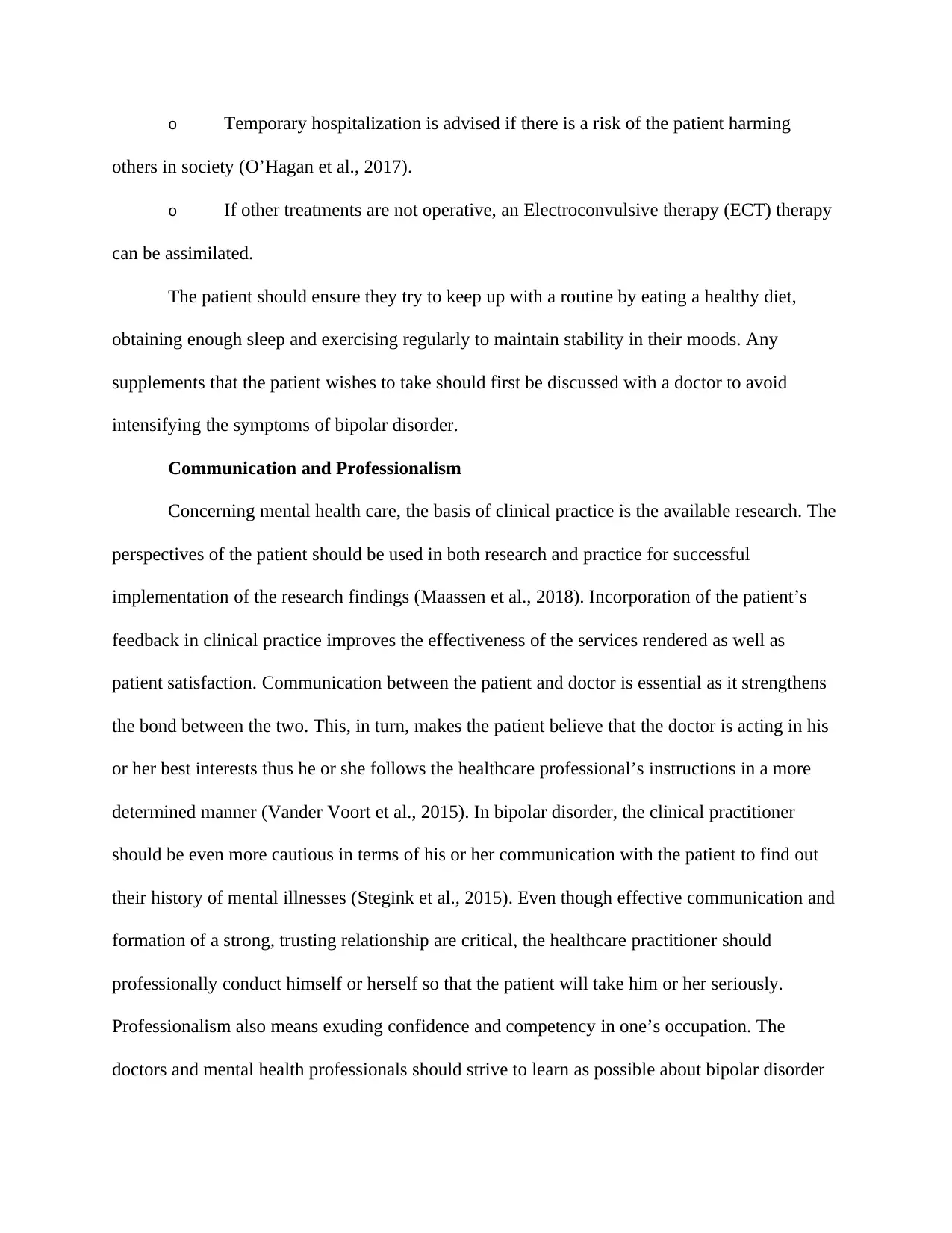
o Temporary hospitalization is advised if there is a risk of the patient harming
others in society (O’Hagan et al., 2017).
o If other treatments are not operative, an Electroconvulsive therapy (ECT) therapy
can be assimilated.
The patient should ensure they try to keep up with a routine by eating a healthy diet,
obtaining enough sleep and exercising regularly to maintain stability in their moods. Any
supplements that the patient wishes to take should first be discussed with a doctor to avoid
intensifying the symptoms of bipolar disorder.
Communication and Professionalism
Concerning mental health care, the basis of clinical practice is the available research. The
perspectives of the patient should be used in both research and practice for successful
implementation of the research findings (Maassen et al., 2018). Incorporation of the patient’s
feedback in clinical practice improves the effectiveness of the services rendered as well as
patient satisfaction. Communication between the patient and doctor is essential as it strengthens
the bond between the two. This, in turn, makes the patient believe that the doctor is acting in his
or her best interests thus he or she follows the healthcare professional’s instructions in a more
determined manner (Vander Voort et al., 2015). In bipolar disorder, the clinical practitioner
should be even more cautious in terms of his or her communication with the patient to find out
their history of mental illnesses (Stegink et al., 2015). Even though effective communication and
formation of a strong, trusting relationship are critical, the healthcare practitioner should
professionally conduct himself or herself so that the patient will take him or her seriously.
Professionalism also means exuding confidence and competency in one’s occupation. The
doctors and mental health professionals should strive to learn as possible about bipolar disorder
others in society (O’Hagan et al., 2017).
o If other treatments are not operative, an Electroconvulsive therapy (ECT) therapy
can be assimilated.
The patient should ensure they try to keep up with a routine by eating a healthy diet,
obtaining enough sleep and exercising regularly to maintain stability in their moods. Any
supplements that the patient wishes to take should first be discussed with a doctor to avoid
intensifying the symptoms of bipolar disorder.
Communication and Professionalism
Concerning mental health care, the basis of clinical practice is the available research. The
perspectives of the patient should be used in both research and practice for successful
implementation of the research findings (Maassen et al., 2018). Incorporation of the patient’s
feedback in clinical practice improves the effectiveness of the services rendered as well as
patient satisfaction. Communication between the patient and doctor is essential as it strengthens
the bond between the two. This, in turn, makes the patient believe that the doctor is acting in his
or her best interests thus he or she follows the healthcare professional’s instructions in a more
determined manner (Vander Voort et al., 2015). In bipolar disorder, the clinical practitioner
should be even more cautious in terms of his or her communication with the patient to find out
their history of mental illnesses (Stegink et al., 2015). Even though effective communication and
formation of a strong, trusting relationship are critical, the healthcare practitioner should
professionally conduct himself or herself so that the patient will take him or her seriously.
Professionalism also means exuding confidence and competency in one’s occupation. The
doctors and mental health professionals should strive to learn as possible about bipolar disorder
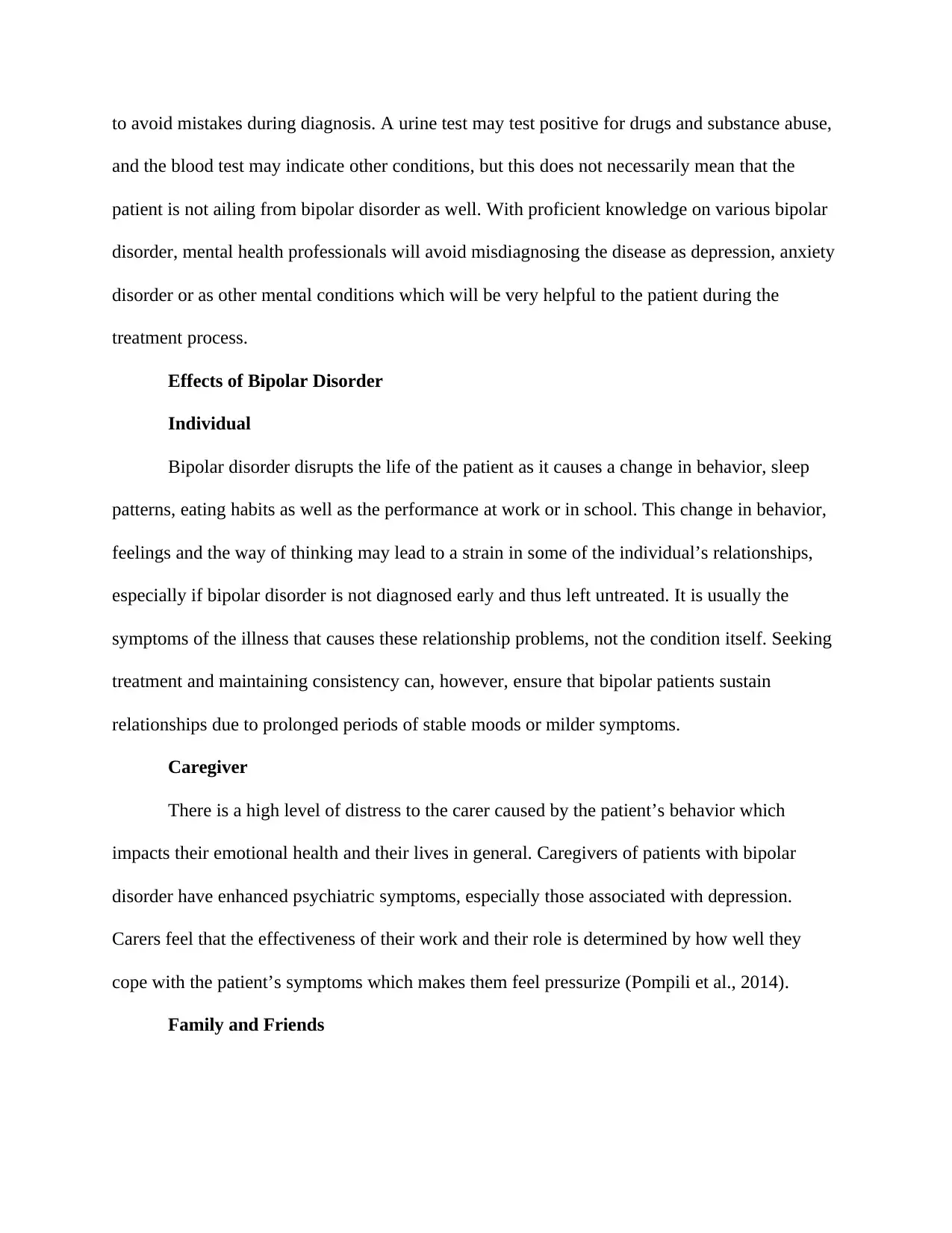
to avoid mistakes during diagnosis. A urine test may test positive for drugs and substance abuse,
and the blood test may indicate other conditions, but this does not necessarily mean that the
patient is not ailing from bipolar disorder as well. With proficient knowledge on various bipolar
disorder, mental health professionals will avoid misdiagnosing the disease as depression, anxiety
disorder or as other mental conditions which will be very helpful to the patient during the
treatment process.
Effects of Bipolar Disorder
Individual
Bipolar disorder disrupts the life of the patient as it causes a change in behavior, sleep
patterns, eating habits as well as the performance at work or in school. This change in behavior,
feelings and the way of thinking may lead to a strain in some of the individual’s relationships,
especially if bipolar disorder is not diagnosed early and thus left untreated. It is usually the
symptoms of the illness that causes these relationship problems, not the condition itself. Seeking
treatment and maintaining consistency can, however, ensure that bipolar patients sustain
relationships due to prolonged periods of stable moods or milder symptoms.
Caregiver
There is a high level of distress to the carer caused by the patient’s behavior which
impacts their emotional health and their lives in general. Caregivers of patients with bipolar
disorder have enhanced psychiatric symptoms, especially those associated with depression.
Carers feel that the effectiveness of their work and their role is determined by how well they
cope with the patient’s symptoms which makes them feel pressurize (Pompili et al., 2014).
Family and Friends
and the blood test may indicate other conditions, but this does not necessarily mean that the
patient is not ailing from bipolar disorder as well. With proficient knowledge on various bipolar
disorder, mental health professionals will avoid misdiagnosing the disease as depression, anxiety
disorder or as other mental conditions which will be very helpful to the patient during the
treatment process.
Effects of Bipolar Disorder
Individual
Bipolar disorder disrupts the life of the patient as it causes a change in behavior, sleep
patterns, eating habits as well as the performance at work or in school. This change in behavior,
feelings and the way of thinking may lead to a strain in some of the individual’s relationships,
especially if bipolar disorder is not diagnosed early and thus left untreated. It is usually the
symptoms of the illness that causes these relationship problems, not the condition itself. Seeking
treatment and maintaining consistency can, however, ensure that bipolar patients sustain
relationships due to prolonged periods of stable moods or milder symptoms.
Caregiver
There is a high level of distress to the carer caused by the patient’s behavior which
impacts their emotional health and their lives in general. Caregivers of patients with bipolar
disorder have enhanced psychiatric symptoms, especially those associated with depression.
Carers feel that the effectiveness of their work and their role is determined by how well they
cope with the patient’s symptoms which makes them feel pressurize (Pompili et al., 2014).
Family and Friends
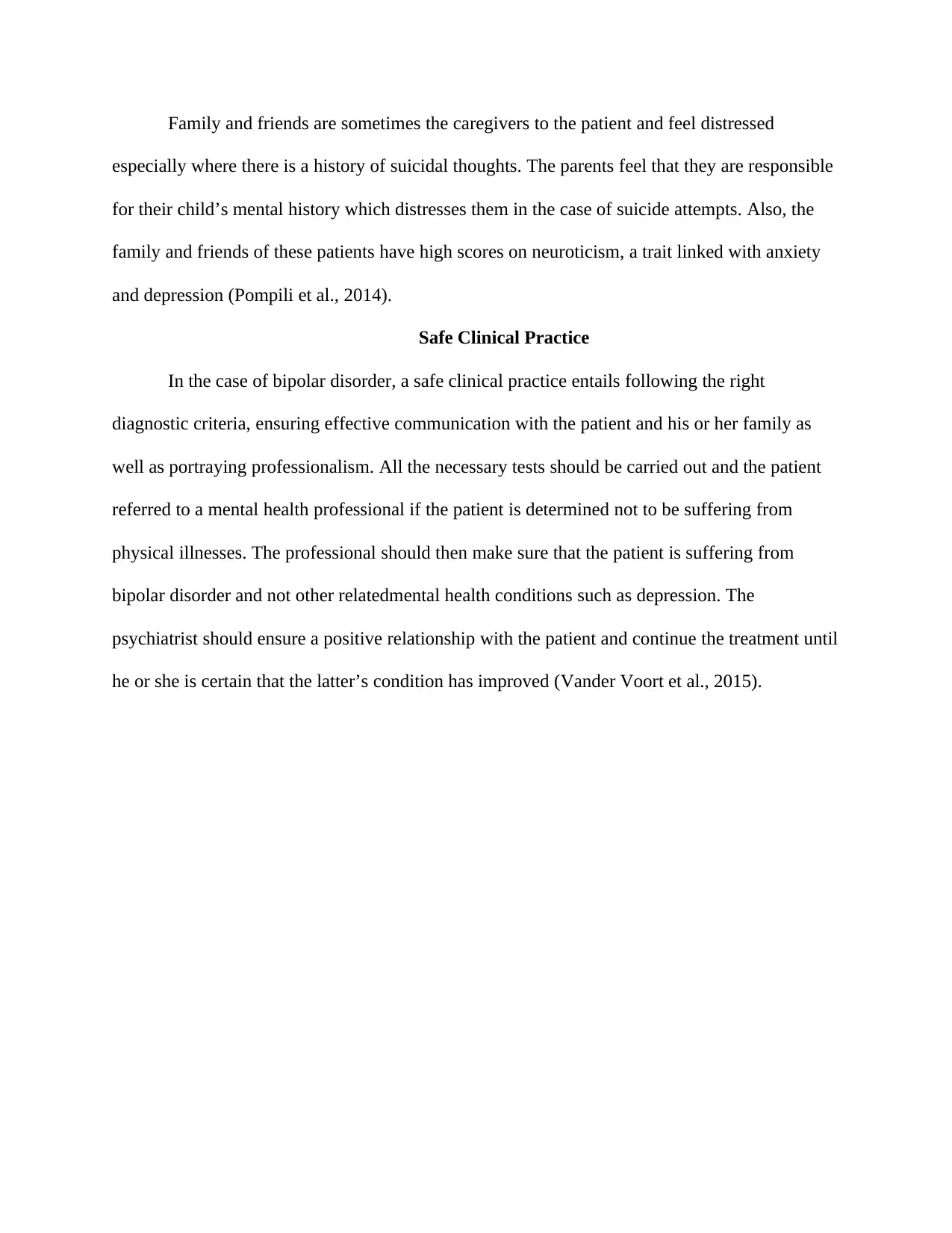
Family and friends are sometimes the caregivers to the patient and feel distressed
especially where there is a history of suicidal thoughts. The parents feel that they are responsible
for their child’s mental history which distresses them in the case of suicide attempts. Also, the
family and friends of these patients have high scores on neuroticism, a trait linked with anxiety
and depression (Pompili et al., 2014).
Safe Clinical Practice
In the case of bipolar disorder, a safe clinical practice entails following the right
diagnostic criteria, ensuring effective communication with the patient and his or her family as
well as portraying professionalism. All the necessary tests should be carried out and the patient
referred to a mental health professional if the patient is determined not to be suffering from
physical illnesses. The professional should then make sure that the patient is suffering from
bipolar disorder and not other relatedmental health conditions such as depression. The
psychiatrist should ensure a positive relationship with the patient and continue the treatment until
he or she is certain that the latter’s condition has improved (Vander Voort et al., 2015).
especially where there is a history of suicidal thoughts. The parents feel that they are responsible
for their child’s mental history which distresses them in the case of suicide attempts. Also, the
family and friends of these patients have high scores on neuroticism, a trait linked with anxiety
and depression (Pompili et al., 2014).
Safe Clinical Practice
In the case of bipolar disorder, a safe clinical practice entails following the right
diagnostic criteria, ensuring effective communication with the patient and his or her family as
well as portraying professionalism. All the necessary tests should be carried out and the patient
referred to a mental health professional if the patient is determined not to be suffering from
physical illnesses. The professional should then make sure that the patient is suffering from
bipolar disorder and not other relatedmental health conditions such as depression. The
psychiatrist should ensure a positive relationship with the patient and continue the treatment until
he or she is certain that the latter’s condition has improved (Vander Voort et al., 2015).
Paraphrase This Document
Need a fresh take? Get an instant paraphrase of this document with our AI Paraphraser
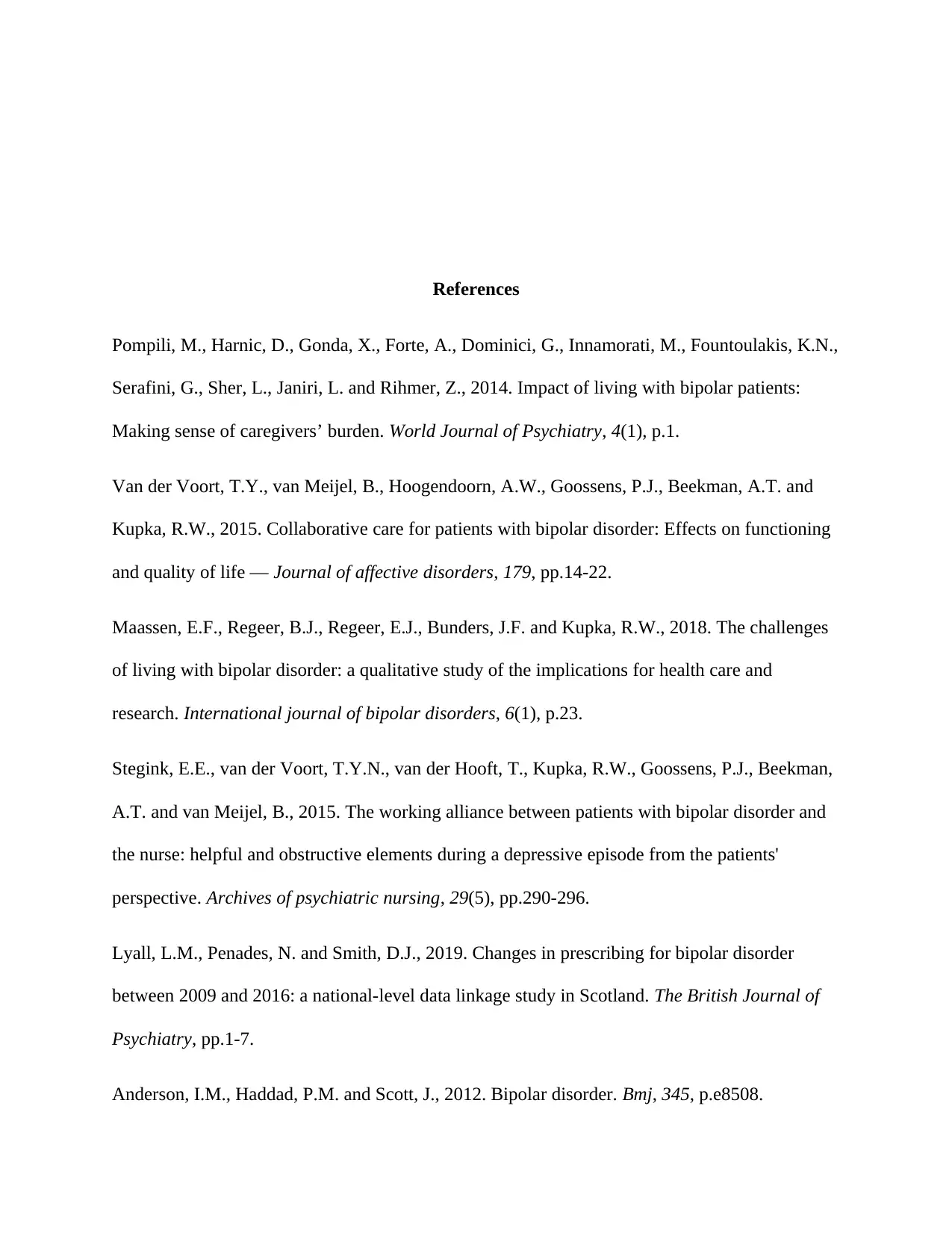
References
Pompili, M., Harnic, D., Gonda, X., Forte, A., Dominici, G., Innamorati, M., Fountoulakis, K.N.,
Serafini, G., Sher, L., Janiri, L. and Rihmer, Z., 2014. Impact of living with bipolar patients:
Making sense of caregivers’ burden. World Journal of Psychiatry, 4(1), p.1.
Van der Voort, T.Y., van Meijel, B., Hoogendoorn, A.W., Goossens, P.J., Beekman, A.T. and
Kupka, R.W., 2015. Collaborative care for patients with bipolar disorder: Effects on functioning
and quality of life — Journal of affective disorders, 179, pp.14-22.
Maassen, E.F., Regeer, B.J., Regeer, E.J., Bunders, J.F. and Kupka, R.W., 2018. The challenges
of living with bipolar disorder: a qualitative study of the implications for health care and
research. International journal of bipolar disorders, 6(1), p.23.
Stegink, E.E., van der Voort, T.Y.N., van der Hooft, T., Kupka, R.W., Goossens, P.J., Beekman,
A.T. and van Meijel, B., 2015. The working alliance between patients with bipolar disorder and
the nurse: helpful and obstructive elements during a depressive episode from the patients'
perspective. Archives of psychiatric nursing, 29(5), pp.290-296.
Lyall, L.M., Penades, N. and Smith, D.J., 2019. Changes in prescribing for bipolar disorder
between 2009 and 2016: a national-level data linkage study in Scotland. The British Journal of
Psychiatry, pp.1-7.
Anderson, I.M., Haddad, P.M. and Scott, J., 2012. Bipolar disorder. Bmj, 345, p.e8508.
Pompili, M., Harnic, D., Gonda, X., Forte, A., Dominici, G., Innamorati, M., Fountoulakis, K.N.,
Serafini, G., Sher, L., Janiri, L. and Rihmer, Z., 2014. Impact of living with bipolar patients:
Making sense of caregivers’ burden. World Journal of Psychiatry, 4(1), p.1.
Van der Voort, T.Y., van Meijel, B., Hoogendoorn, A.W., Goossens, P.J., Beekman, A.T. and
Kupka, R.W., 2015. Collaborative care for patients with bipolar disorder: Effects on functioning
and quality of life — Journal of affective disorders, 179, pp.14-22.
Maassen, E.F., Regeer, B.J., Regeer, E.J., Bunders, J.F. and Kupka, R.W., 2018. The challenges
of living with bipolar disorder: a qualitative study of the implications for health care and
research. International journal of bipolar disorders, 6(1), p.23.
Stegink, E.E., van der Voort, T.Y.N., van der Hooft, T., Kupka, R.W., Goossens, P.J., Beekman,
A.T. and van Meijel, B., 2015. The working alliance between patients with bipolar disorder and
the nurse: helpful and obstructive elements during a depressive episode from the patients'
perspective. Archives of psychiatric nursing, 29(5), pp.290-296.
Lyall, L.M., Penades, N. and Smith, D.J., 2019. Changes in prescribing for bipolar disorder
between 2009 and 2016: a national-level data linkage study in Scotland. The British Journal of
Psychiatry, pp.1-7.
Anderson, I.M., Haddad, P.M. and Scott, J., 2012. Bipolar disorder. Bmj, 345, p.e8508.
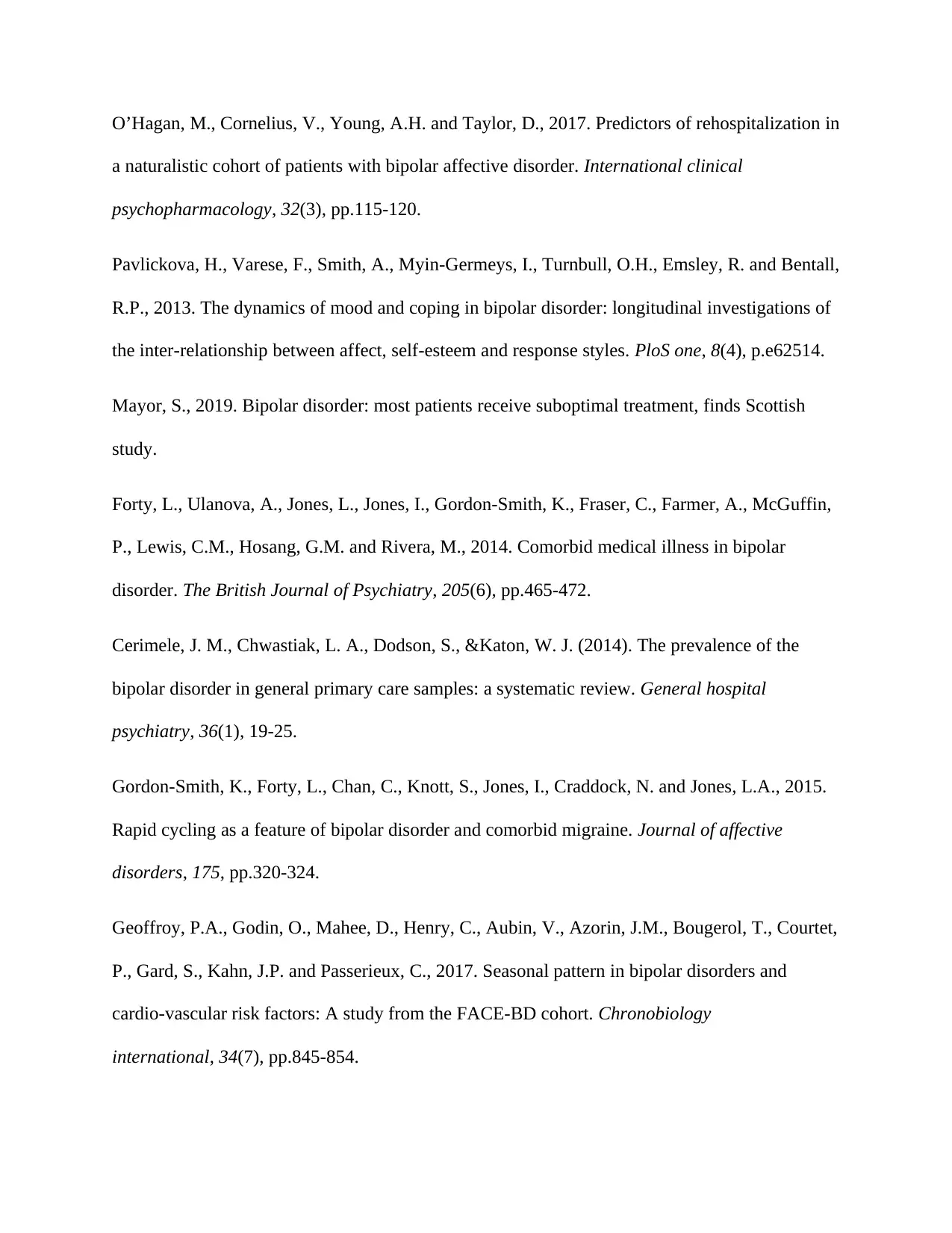
O’Hagan, M., Cornelius, V., Young, A.H. and Taylor, D., 2017. Predictors of rehospitalization in
a naturalistic cohort of patients with bipolar affective disorder. International clinical
psychopharmacology, 32(3), pp.115-120.
Pavlickova, H., Varese, F., Smith, A., Myin-Germeys, I., Turnbull, O.H., Emsley, R. and Bentall,
R.P., 2013. The dynamics of mood and coping in bipolar disorder: longitudinal investigations of
the inter-relationship between affect, self-esteem and response styles. PloS one, 8(4), p.e62514.
Mayor, S., 2019. Bipolar disorder: most patients receive suboptimal treatment, finds Scottish
study.
Forty, L., Ulanova, A., Jones, L., Jones, I., Gordon-Smith, K., Fraser, C., Farmer, A., McGuffin,
P., Lewis, C.M., Hosang, G.M. and Rivera, M., 2014. Comorbid medical illness in bipolar
disorder. The British Journal of Psychiatry, 205(6), pp.465-472.
Cerimele, J. M., Chwastiak, L. A., Dodson, S., &Katon, W. J. (2014). The prevalence of the
bipolar disorder in general primary care samples: a systematic review. General hospital
psychiatry, 36(1), 19-25.
Gordon-Smith, K., Forty, L., Chan, C., Knott, S., Jones, I., Craddock, N. and Jones, L.A., 2015.
Rapid cycling as a feature of bipolar disorder and comorbid migraine. Journal of affective
disorders, 175, pp.320-324.
Geoffroy, P.A., Godin, O., Mahee, D., Henry, C., Aubin, V., Azorin, J.M., Bougerol, T., Courtet,
P., Gard, S., Kahn, J.P. and Passerieux, C., 2017. Seasonal pattern in bipolar disorders and
cardio-vascular risk factors: A study from the FACE-BD cohort. Chronobiology
international, 34(7), pp.845-854.
a naturalistic cohort of patients with bipolar affective disorder. International clinical
psychopharmacology, 32(3), pp.115-120.
Pavlickova, H., Varese, F., Smith, A., Myin-Germeys, I., Turnbull, O.H., Emsley, R. and Bentall,
R.P., 2013. The dynamics of mood and coping in bipolar disorder: longitudinal investigations of
the inter-relationship between affect, self-esteem and response styles. PloS one, 8(4), p.e62514.
Mayor, S., 2019. Bipolar disorder: most patients receive suboptimal treatment, finds Scottish
study.
Forty, L., Ulanova, A., Jones, L., Jones, I., Gordon-Smith, K., Fraser, C., Farmer, A., McGuffin,
P., Lewis, C.M., Hosang, G.M. and Rivera, M., 2014. Comorbid medical illness in bipolar
disorder. The British Journal of Psychiatry, 205(6), pp.465-472.
Cerimele, J. M., Chwastiak, L. A., Dodson, S., &Katon, W. J. (2014). The prevalence of the
bipolar disorder in general primary care samples: a systematic review. General hospital
psychiatry, 36(1), 19-25.
Gordon-Smith, K., Forty, L., Chan, C., Knott, S., Jones, I., Craddock, N. and Jones, L.A., 2015.
Rapid cycling as a feature of bipolar disorder and comorbid migraine. Journal of affective
disorders, 175, pp.320-324.
Geoffroy, P.A., Godin, O., Mahee, D., Henry, C., Aubin, V., Azorin, J.M., Bougerol, T., Courtet,
P., Gard, S., Kahn, J.P. and Passerieux, C., 2017. Seasonal pattern in bipolar disorders and
cardio-vascular risk factors: A study from the FACE-BD cohort. Chronobiology
international, 34(7), pp.845-854.
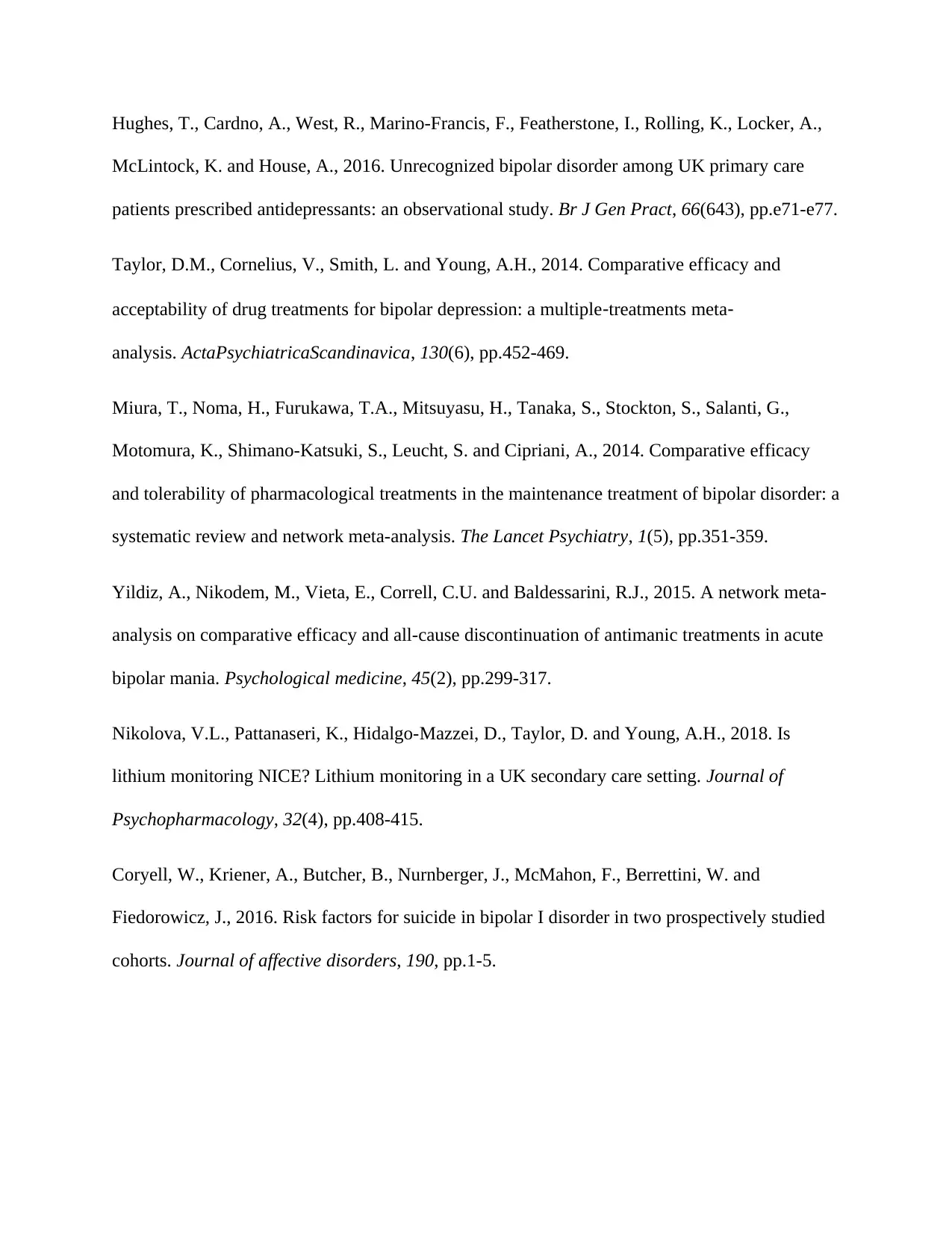
Hughes, T., Cardno, A., West, R., Marino-Francis, F., Featherstone, I., Rolling, K., Locker, A.,
McLintock, K. and House, A., 2016. Unrecognized bipolar disorder among UK primary care
patients prescribed antidepressants: an observational study. Br J Gen Pract, 66(643), pp.e71-e77.
Taylor, D.M., Cornelius, V., Smith, L. and Young, A.H., 2014. Comparative efficacy and
acceptability of drug treatments for bipolar depression: a multiple‐treatments meta‐
analysis. ActaPsychiatricaScandinavica, 130(6), pp.452-469.
Miura, T., Noma, H., Furukawa, T.A., Mitsuyasu, H., Tanaka, S., Stockton, S., Salanti, G.,
Motomura, K., Shimano-Katsuki, S., Leucht, S. and Cipriani, A., 2014. Comparative efficacy
and tolerability of pharmacological treatments in the maintenance treatment of bipolar disorder: a
systematic review and network meta-analysis. The Lancet Psychiatry, 1(5), pp.351-359.
Yildiz, A., Nikodem, M., Vieta, E., Correll, C.U. and Baldessarini, R.J., 2015. A network meta-
analysis on comparative efficacy and all-cause discontinuation of antimanic treatments in acute
bipolar mania. Psychological medicine, 45(2), pp.299-317.
Nikolova, V.L., Pattanaseri, K., Hidalgo-Mazzei, D., Taylor, D. and Young, A.H., 2018. Is
lithium monitoring NICE? Lithium monitoring in a UK secondary care setting. Journal of
Psychopharmacology, 32(4), pp.408-415.
Coryell, W., Kriener, A., Butcher, B., Nurnberger, J., McMahon, F., Berrettini, W. and
Fiedorowicz, J., 2016. Risk factors for suicide in bipolar I disorder in two prospectively studied
cohorts. Journal of affective disorders, 190, pp.1-5.
McLintock, K. and House, A., 2016. Unrecognized bipolar disorder among UK primary care
patients prescribed antidepressants: an observational study. Br J Gen Pract, 66(643), pp.e71-e77.
Taylor, D.M., Cornelius, V., Smith, L. and Young, A.H., 2014. Comparative efficacy and
acceptability of drug treatments for bipolar depression: a multiple‐treatments meta‐
analysis. ActaPsychiatricaScandinavica, 130(6), pp.452-469.
Miura, T., Noma, H., Furukawa, T.A., Mitsuyasu, H., Tanaka, S., Stockton, S., Salanti, G.,
Motomura, K., Shimano-Katsuki, S., Leucht, S. and Cipriani, A., 2014. Comparative efficacy
and tolerability of pharmacological treatments in the maintenance treatment of bipolar disorder: a
systematic review and network meta-analysis. The Lancet Psychiatry, 1(5), pp.351-359.
Yildiz, A., Nikodem, M., Vieta, E., Correll, C.U. and Baldessarini, R.J., 2015. A network meta-
analysis on comparative efficacy and all-cause discontinuation of antimanic treatments in acute
bipolar mania. Psychological medicine, 45(2), pp.299-317.
Nikolova, V.L., Pattanaseri, K., Hidalgo-Mazzei, D., Taylor, D. and Young, A.H., 2018. Is
lithium monitoring NICE? Lithium monitoring in a UK secondary care setting. Journal of
Psychopharmacology, 32(4), pp.408-415.
Coryell, W., Kriener, A., Butcher, B., Nurnberger, J., McMahon, F., Berrettini, W. and
Fiedorowicz, J., 2016. Risk factors for suicide in bipolar I disorder in two prospectively studied
cohorts. Journal of affective disorders, 190, pp.1-5.
Secure Best Marks with AI Grader
Need help grading? Try our AI Grader for instant feedback on your assignments.

1 out of 17
Related Documents
Your All-in-One AI-Powered Toolkit for Academic Success.
+13062052269
info@desklib.com
Available 24*7 on WhatsApp / Email
![[object Object]](/_next/static/media/star-bottom.7253800d.svg)
Unlock your academic potential
© 2024 | Zucol Services PVT LTD | All rights reserved.




